
The ultimate goal of conservation initiatives at the Botanical Garden is protection of plant species, habitats, and ecosystems from degradation and extinction—thereby reducing the negative consequences for human well-being and the biological diversity of the planet. The first prerequisite for protecting plant species, habitats, and ecosystems is identifying those species at risk of extinction. Armed with this information, Garden scientists and collaborators work to develop sustainable management plans for protecting at-risk species and ecosystems. Solutions often involve understanding what conservation measures can be effective in a particular place, at a local level.


The Garden is uniquely poised to inform the conservation process and identify priority species and places for conservation. Garden scientists are specialists on fungi and plant groups throughout the plant kingdom—from ancient lineages such as algae, ferns, and gymnosperms to the many families of flowering plants that make up 80 percent of the plant diversity on Earth today. Their expertise extends to specific knowledge of plant species growing in many places on Earth, including North America, the Caribbean region, the Brazil Coastal Forest, the Amazon Basin, Pacifica, and Southeast Asia, among others. Garden scientists have established an international network of collaborative ties with governments, traditional leaders, conservation organizations, and fellow scientists about plant diversity issues.

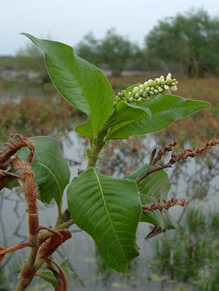

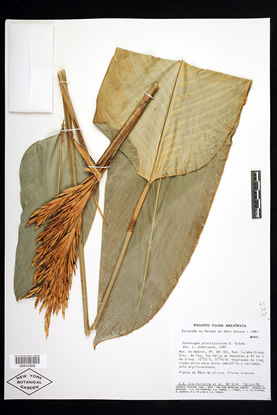
The more than 7 million plant collections in the Garden's William and Lynda Steere Herbarium date from the 18th century to the present and document fungal and plant species diversity from every continent on Earth, with exceptional strength in the Americas. The associated C.V. Starr Virtual Herbarium provides instant Internet access to information on fungal and plant diversity in the Steere Herbarium. Using information from the Steere Herbarium and other sources, the Garden's Geographic Information Systems (GIS) Laboratory enables data-intensive analysis and identification of plant species at risk of extinction and of geographic regions with high concentrations of species that are of conservation concern.
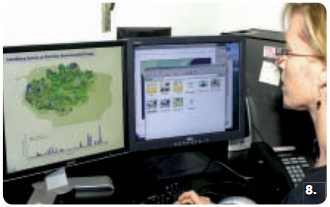
Beyond great expertise in plant diversity and unmatched resources and facilities for conservation analysis, Garden scientists have developed novel techniques to rapidly assess the conservation status of plant species and have developed a habitat classification system using climate information and a new GIS model.
Selected Projects
The New York Botanical Garden's Threatened Plants Program, Phase I: The Puerto Rican Endangered Plants Initiative. This project—led by Garden scientists Drs. James Miller and Holly Porter-Morgan, Geographic Information Systems (GIS) specialist Hannah Stevens, and Puerto Rican colleagues—is using novel rapid-assessment protocols to evaluate which of the approximately 3,300 Puerto Rican plant species are threatened with extinction and which are not. A preliminary study using the new protocols and readily available Puerto Rican specimen data from the Garden's C.V. Starr Virtual Herbarium and the Global Biodiversity Information Facility (GBIF) indicate that as many as one in five Puerto Rican plant species are threatened or near threatened. Find out more information on page 6 of this PDF.
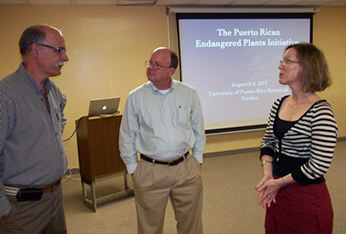 Dr. James Miller (center), Dean and Vice President for Botanical Science at the Garden, and Hannah Stevens (right) GIS specialist at the Garden, discuss the Puerto Rican Endangered Plants Initiative with Rafael Davila, Director of the University of Puerto Rico Botanical Garden.
Dr. James Miller (center), Dean and Vice President for Botanical Science at the Garden, and Hannah Stevens (right) GIS specialist at the Garden, discuss the Puerto Rican Endangered Plants Initiative with Rafael Davila, Director of the University of Puerto Rico Botanical Garden.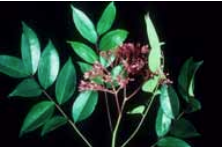 This at-risk species, Simarouba tulae (Simaroubaceae), can be found growing in Reserva Tres Picachos, Puerto Rico.
This at-risk species, Simarouba tulae (Simaroubaceae), can be found growing in Reserva Tres Picachos, Puerto Rico. The rare tree species Magnolia portoricensis grows only in the mountains of Puerto Rico. This species is among those being assessed for their at-risk status using the novel, rapid protocol pioneered through this project. Click to visit this specimen in the Garden's C.V. Starr Virtual Herbarium.
The rare tree species Magnolia portoricensis grows only in the mountains of Puerto Rico. This species is among those being assessed for their at-risk status using the novel, rapid protocol pioneered through this project. Click to visit this specimen in the Garden's C.V. Starr Virtual Herbarium.Native Plants and the Spread of Invasives in the Northeastern United States. Led by Garden scientist Dr. Robert Naczi, the project is inventorying the plants occurring in all or portions of 22 states in the northeastern United States and in five Canadian provinces. The Garden's first in-depth flora of this area, published in 1896, provides baseline data for plants occurring in this vast geographic area more than a century ago. The contemporary inventory of the same area will identify new species, species extinctions, the spread of invasive non-native species, and shifts in the geographic ranges of species that may be due to environmental factors such as habitat loss and climate change. As it has for the last century, the flora—including an online version with identification keys— will be a primary reference for conservation of the area's natural resources. Find out more information
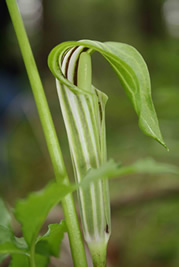 Jack-in-the-pulpit (Arisaema triphylum subspecies stewardsonii, Araceae), one of many native plants of the Northeast needing updated scientific classification. Garden science interns have recently helped accumulate evidence that some subspecies of Jack-in-the-pulpit warrant species status.
Jack-in-the-pulpit (Arisaema triphylum subspecies stewardsonii, Araceae), one of many native plants of the Northeast needing updated scientific classification. Garden science interns have recently helped accumulate evidence that some subspecies of Jack-in-the-pulpit warrant species status.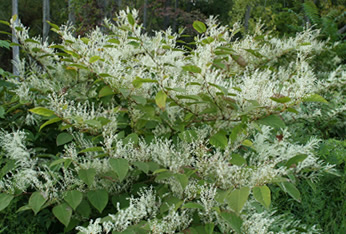 Japanese knotweed (Fallopia japonica, Polygonaceae) has invaded countless natural areas throughout the Northeast, causing the elimination of native species and the disruption of ecological processes in these areas.
Japanese knotweed (Fallopia japonica, Polygonaceae) has invaded countless natural areas throughout the Northeast, causing the elimination of native species and the disruption of ecological processes in these areas.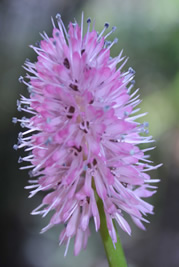 Swamp pink (Helonias bullata, Melanthiaceae), one of many native plants of the Northeast that have declined severely in recent decades and are now extirpated from (locally extinct in) large portions of their former geographic ranges. The last known sighting of Helonias in New York state was in the 1890s.
Swamp pink (Helonias bullata, Melanthiaceae), one of many native plants of the Northeast that have declined severely in recent decades and are now extirpated from (locally extinct in) large portions of their former geographic ranges. The last known sighting of Helonias in New York state was in the 1890s.
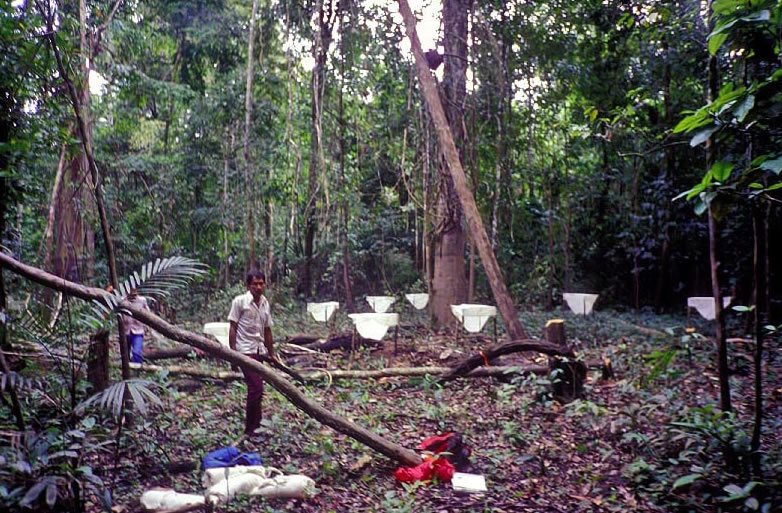
Garden scientists work to develop management plans for protecting plant diversity and the ability of ecosystems to provide vital resources and services for humans and other organisms—now and into the future. Such management plans are often referred to as sustainable management plans for their focus on balancing use and preservation that can allow plant diversity, ecosystems, and human well-being to endure. The first step in developing a sustainable management plan is to identify the plant diversity in the area of concern.
Selected Projects
Sustainably Managing a United Nations Biosphere Reserve in the Dominican Republic. The Jaragua-Bahoruco-Enriquillo Biosphere Reserve in the southwest corner of the Dominican Republic encompasses three biogeographic regions in the Caribbean, a great variety of ecosystems, and a rich diversity of plants, many species of which are found nowhere else. Led by Garden scientist Dr. Brian Boom, the project is combining field expeditions and herbarium studies with modern digital imaging techniques and Geographic Information Systems (GIS) analyses to acquire, analyze, and disseminate critically missing data on plant diversity and endangered species in the Reserve. Data will be used in three ways: to identify the most important routes for "biodiversity corridors" that should be preserved to connect the Reserve's core areas; to document the globally threatened plant species that are endangered locally due to economic pressures; and to promote the sustainable management of those at-risk plant resources by the local people who live in the Reserve's transition and buffer zones.
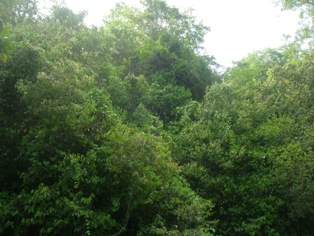 Moist forest in the area of the proposed biological corridor, Mapioró-El Tunal, Dominican Republic.
Moist forest in the area of the proposed biological corridor, Mapioró-El Tunal, Dominican Republic.
Image: J. Salazar.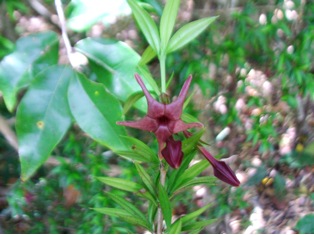 Isidorea leptantha (Rubiaceae), a rare species occurring in the proposed biological corridor, Mapioró-El Tunal, Dominican Republic.
Isidorea leptantha (Rubiaceae), a rare species occurring in the proposed biological corridor, Mapioró-El Tunal, Dominican Republic.
Please use this image credit: Image J. Salazar.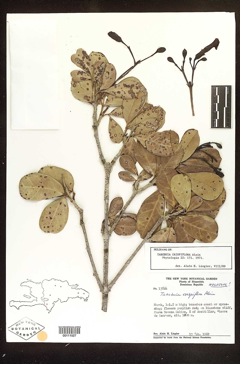 Locality data from this herbarium specimen and others was used to map distribution of a threatened species, Tabebuia crispiflora, in the Biosphere Reserve. Click to visit this specimen in the Garden’s C.V. Starr Virtual Herbarium.
Locality data from this herbarium specimen and others was used to map distribution of a threatened species, Tabebuia crispiflora, in the Biosphere Reserve. Click to visit this specimen in the Garden’s C.V. Starr Virtual Herbarium.Sustainably Managing Rattan Palms in Vietnam. About one in every seven canes that enters the international rattan industry comes from Vietnam, and many of these are harvested illegally from protected areas in the Central Truong Son Mountains. Led by Garden scientists Drs. Charles Peters and Andrew Henderson, the project is documenting the species diversity of rattan palms in six reserves in this area and training local forestry staff in their identification. Inventories are determining density, size structure, and rates of regeneration of wild rattan populations. Project data will inform plans to sustainably manage rattans by local communities and to design certification for sustainably harvested rattan in Vietnam.
 Project collaborator Dr. Ninh Khac Ban (right) showing local forestry staff how to identify “may sap” (Calamus dioicus), one of at least 20 local rattans in the Song Thanh Nature Reserve in Vietnam.
Project collaborator Dr. Ninh Khac Ban (right) showing local forestry staff how to identify “may sap” (Calamus dioicus), one of at least 20 local rattans in the Song Thanh Nature Reserve in Vietnam.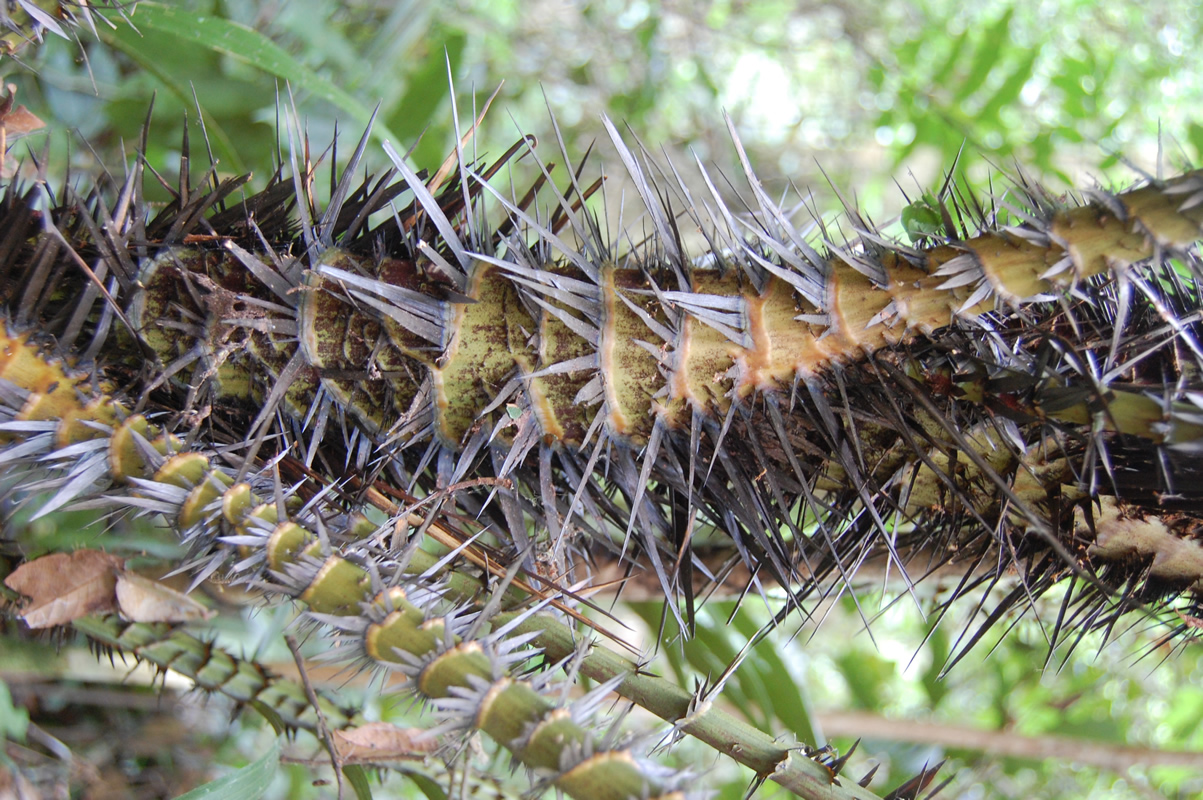 Close-up of the rattan palm Calamus rhabdocladus growing in CucPhuong National Park,Vietnam. This is what rattan looks like before the leaf sheath is stripped off to extract the cane.
Close-up of the rattan palm Calamus rhabdocladus growing in CucPhuong National Park,Vietnam. This is what rattan looks like before the leaf sheath is stripped off to extract the cane.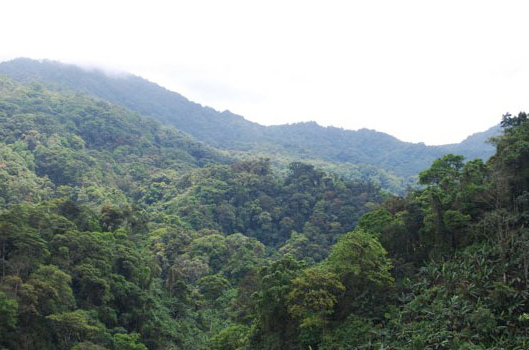 The Central Truong Son Mountains in Vietnam contain steep slopes, a few leeches, and lots and lots of rattan palm.
The Central Truong Son Mountains in Vietnam contain steep slopes, a few leeches, and lots and lots of rattan palm.
Locally appropriate conservation protects plant diversity and enhances the environmental and cultural uniqueness and economic health of a particular place. Garden scientists work in close collaboration with local scientists and people, governmental agencies, scientific institutions, and NGOs to determine locally appropriate conservation measures for protecting plant diversity in some of the most remarkable places on Earth.
Selected Projects
Developing Conservation Plans for the Atlantic Coastal Forest of Brazil. The unique Brazil Coastal Forest has been reduced to fragments occupying less than 7 percent of its original extent, and many of the remaining plant species are found nowhere else on Earth. Led by Garden scientist Dr. William Wayt Thomas in collaboration with Brazilian institutions, scientists, and NGOs, the project is documenting plant species in forest fragments in the State of Bahia and developing plans to protect the fragments containing species most at risk. Find out more information.
Shedding Light on the Interdependence of Lemurs and Fruiting Trees in Madagascar. The fruit-eating lemur from the remote, isolated island of Madagascar was identified in 1987 as the most gravely endangered primate in the world. Little is known about lemurs' primary food source—the fruits of ramy trees (Canarium spp., Burseraceae). Led by Garden scientist Dr. Douglas Daly, the project is documenting species of Canarium on Madagascar. It is also looking at whether different species flower and fruit at staggered times, providing an extended season of food for lemurs; whether any species are endangered, resulting in special dangers for lemurs at certain times of the year; and whether all species of lemurs eat all species of Canarium.
Conservation in Cuba. Endemic species are those which are only found in a given region or location and nowhere else on Earth. Led by Garden scientist Dr. Brian Boom, the project is looking closely at plant species endemic to Cuba and assessing the degree of threat presented to each of them by climate change and local habitat degradation and loss. Data from the project are informing decision-making for conservation measures in Cuba and building capacity for future scientific study, conservation, and sustainable management plans among Cuban scientists and governmental agencies. Find out more information.
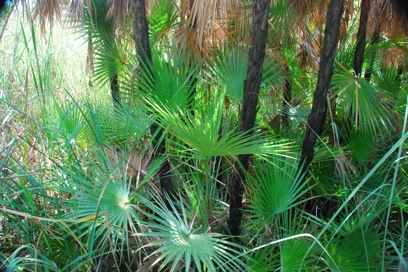 Although scientists have been documenting Yosemite's exceptional vascular plant diversity for more than 150 years, very little is known about its freshwater algae. A preliminary survey of 44 (1.5 percent) of Yosemite's lakes, by Garden scientist Dr. Kenneth Karol and colleagues, indicates that species diversity of freshwater algae is similarly high.
Although scientists have been documenting Yosemite's exceptional vascular plant diversity for more than 150 years, very little is known about its freshwater algae. A preliminary survey of 44 (1.5 percent) of Yosemite's lakes, by Garden scientist Dr. Kenneth Karol and colleagues, indicates that species diversity of freshwater algae is similarly high.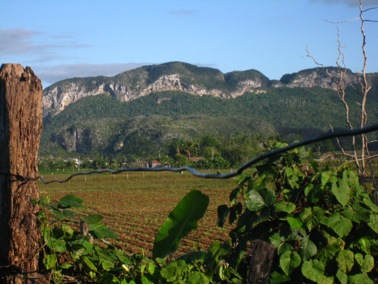 Species of the macroscopic green alga Nitella provide food and shelter for a variety of other organisms in Yosemite National Park. They also play a key role in stabilizing sediment and maintaining water clarity.
Species of the macroscopic green alga Nitella provide food and shelter for a variety of other organisms in Yosemite National Park. They also play a key role in stabilizing sediment and maintaining water clarity.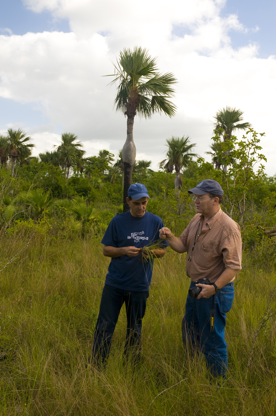 >Algae, such as Xanthidium pictured here, are some of Yosemite National Park's primary producers, and, along with other microscopic algae, play a vital role in Yosemite's fragile food web.
>Algae, such as Xanthidium pictured here, are some of Yosemite National Park's primary producers, and, along with other microscopic algae, play a vital role in Yosemite's fragile food web.Exploring and Conserving Plant Diversity in the Andes Mountains of South America. Led by Garden scientist Dr. Paola Pedraza, this umbrella project is working to explore, understand, and conserve the plants of the tropical Andes mountain system. An in-depth study of one large plant group—tropical relatives of blueberries in Peru, Bolivia, and Colombia, of which almost 50 percent are endangered species—is leading to a better understanding of the evolution, distribution patterns and threats to the entire Andean flora. In-depth plant inventories and published field guides to particular areas—such as Sumapaz National Park in Colombia, part of the largest páramo (high-altitude alpine-like) ecosystem in the world—are identifying species at potentially high risk of extinction and providing data for decision-makers to prepare effective conservation management plans. Find out more information
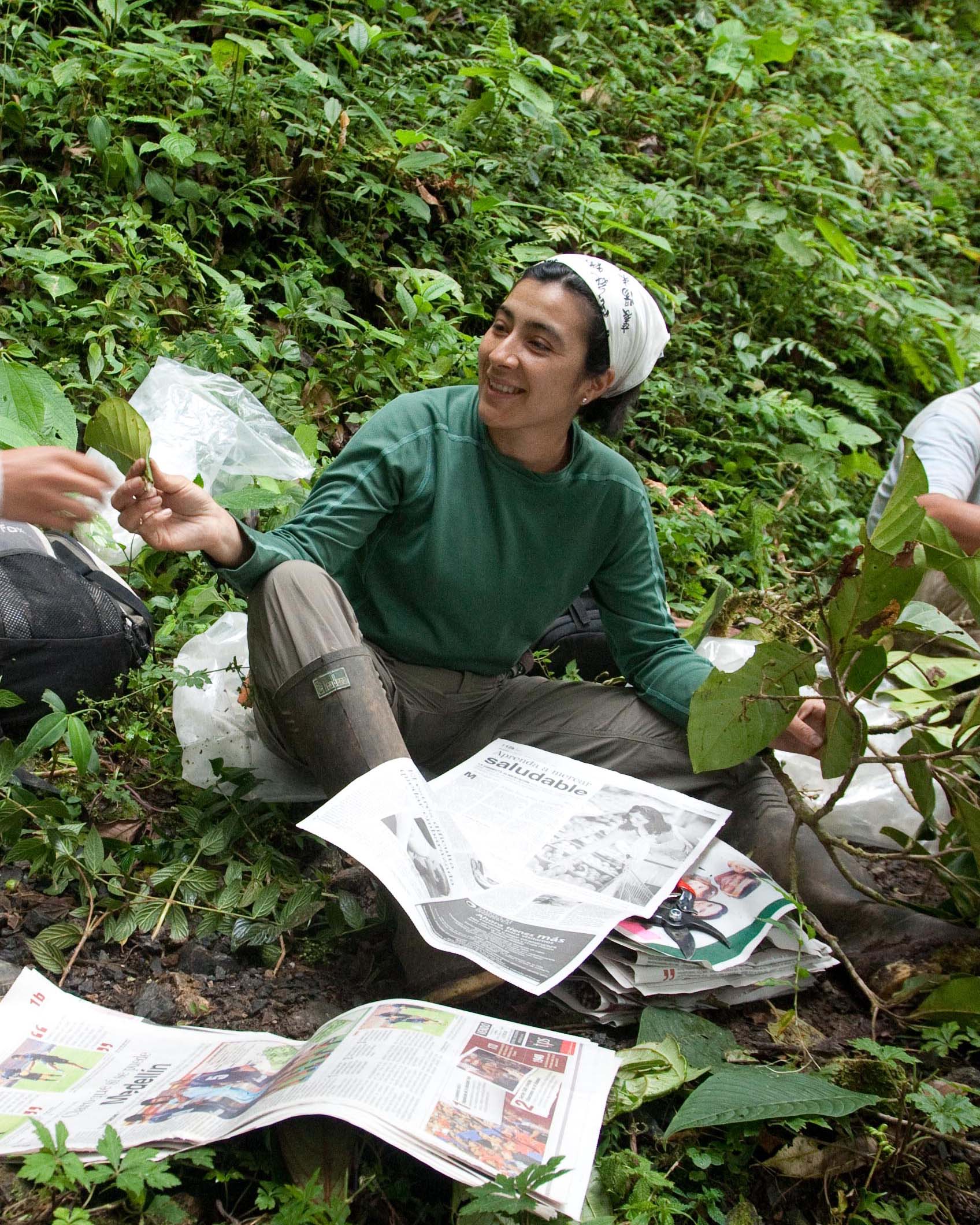 Garden scientist Dr. Paola Pedraza at work in the Andes Mountains of South America.
Garden scientist Dr. Paola Pedraza at work in the Andes Mountains of South America.
Image by Fredy Gómez.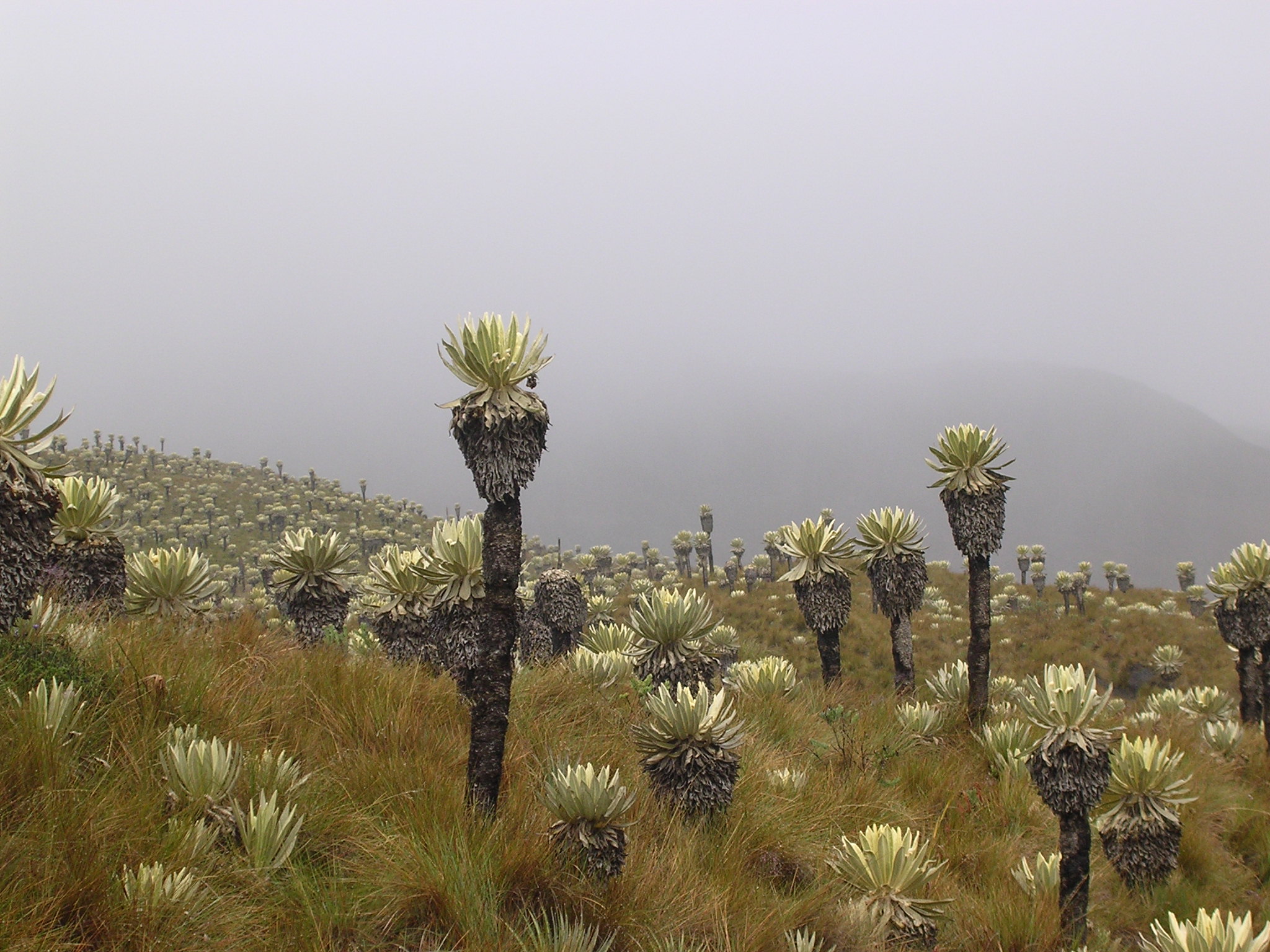 Páramos are the uppermost type of vegetation of the highest mountains of the New World tropics. They are often dominated by species of the genus Espeletia (Asteraceae), a beautiful plant known locally as frailejón.
Páramos are the uppermost type of vegetation of the highest mountains of the New World tropics. They are often dominated by species of the genus Espeletia (Asteraceae), a beautiful plant known locally as frailejón.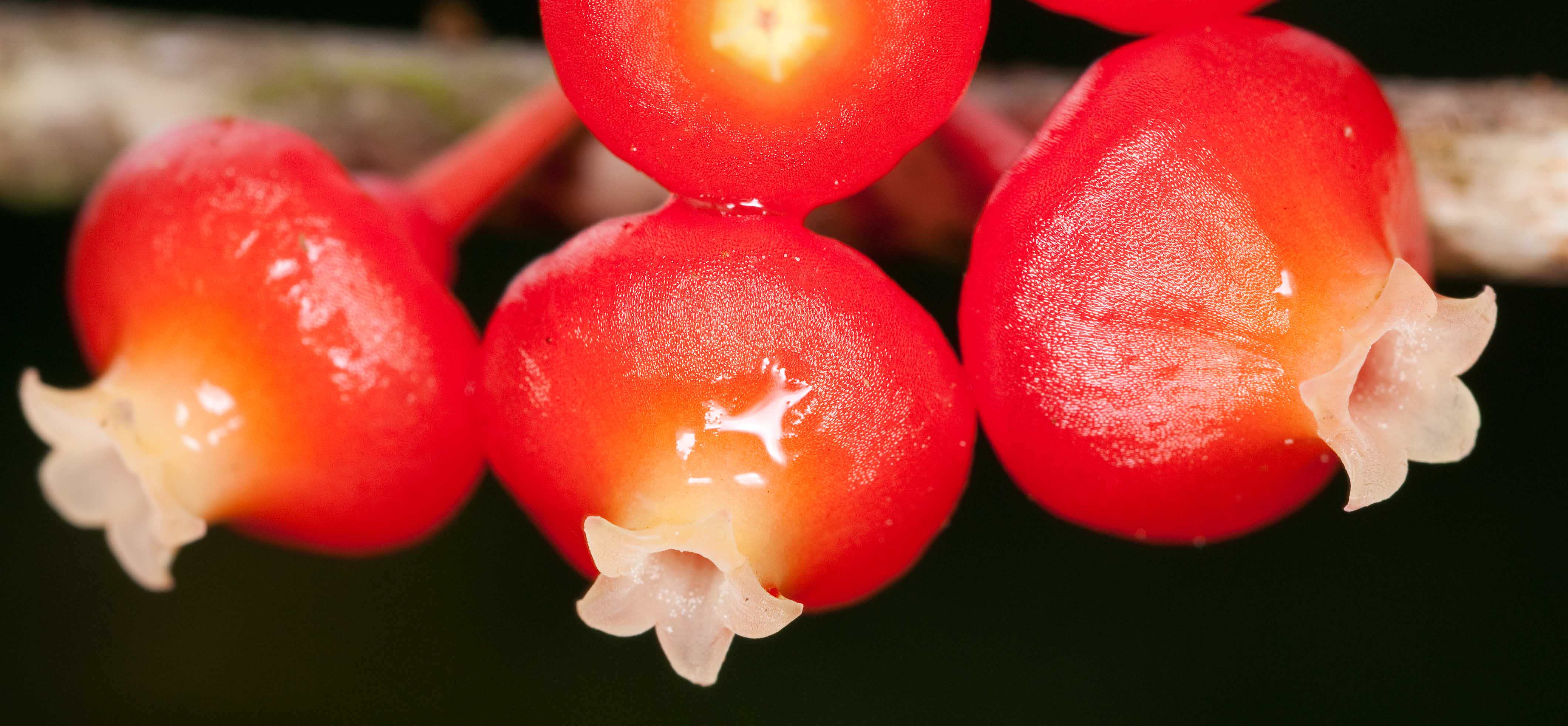 There are hundreds of relatives of blueberries in the tropics, not all of them with blue berries. Many of them occur nowhere else (endemic species), like Psammisia pedunculata pictured here. The many blueberry relatives are an example of the high plant species diversity that has evolved in the Andes Mountains.
There are hundreds of relatives of blueberries in the tropics, not all of them with blue berries. Many of them occur nowhere else (endemic species), like Psammisia pedunculata pictured here. The many blueberry relatives are an example of the high plant species diversity that has evolved in the Andes Mountains.Inventorying the Green Algae in Yosemite National Park. Green algae are important primary producers, playing essential roles in many ecosystems. They also provide food and shelter for a variety of other organisms. Led by Garden scientist Dr. Kenneth G. Karol, the project is inventorying the species diversity of freshwater green algae in Yosemite National Park's lakes, pools, bogs, and streams throughout an annual growing season. In addition to documenting new species, data from the project are helping to detect effects of climate change, development, and tourism on the National Park and to inform decision-making about future land use in the Park and surrounding areas.
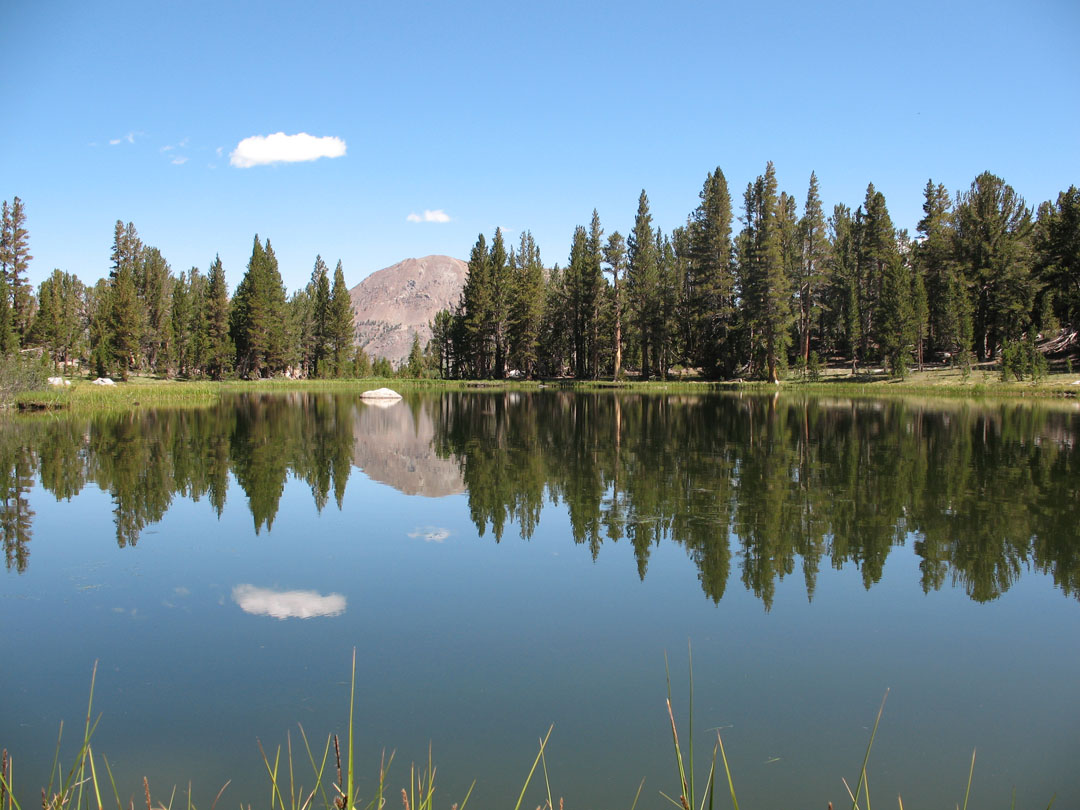 Although scientists have been documenting Yosemite’s exceptional vascular plant diversity for more than 150 years, very little is known about its freshwater algae. A preliminary survey of 44 (1.5 percent) of Yosemite’s lakes, by Garden scientist Dr. Kenneth Karol and colleagues, indicates that species diversity of freshwater algae is similarly high.
Although scientists have been documenting Yosemite’s exceptional vascular plant diversity for more than 150 years, very little is known about its freshwater algae. A preliminary survey of 44 (1.5 percent) of Yosemite’s lakes, by Garden scientist Dr. Kenneth Karol and colleagues, indicates that species diversity of freshwater algae is similarly high. Species of the macroscopic green alga Nitella provide food and shelter for a variety of other organisms in Yosemite National Park. They also play a key role in stabilizing sediment and maintaining water clarity.
Species of the macroscopic green alga Nitella provide food and shelter for a variety of other organisms in Yosemite National Park. They also play a key role in stabilizing sediment and maintaining water clarity.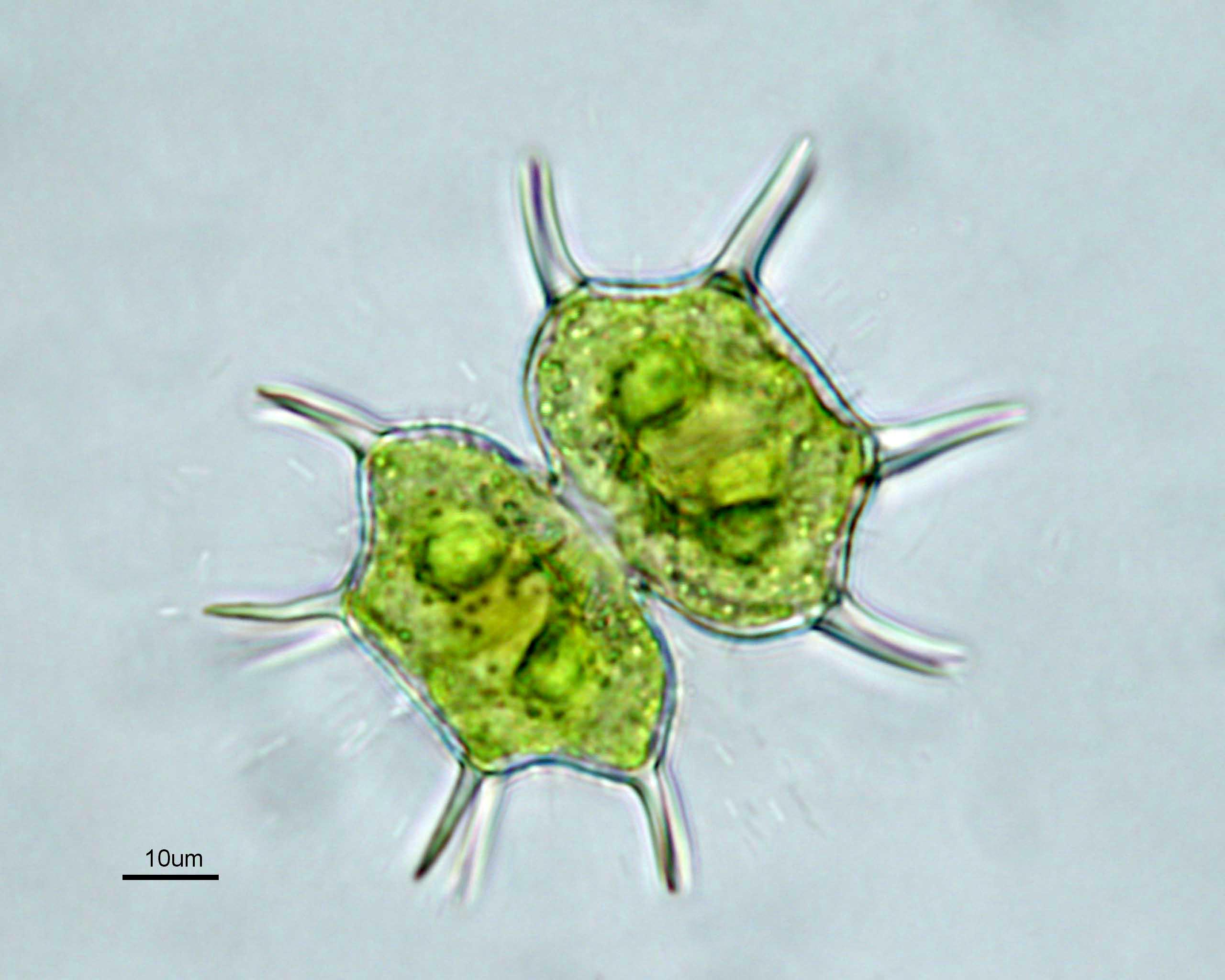 Algae, such as Xanthidium pictured here, are some of Yosemite National Park’s primary producers, and, along with other microscopic algae, play a vital role in Yosemite’s fragile food web.
Algae, such as Xanthidium pictured here, are some of Yosemite National Park’s primary producers, and, along with other microscopic algae, play a vital role in Yosemite’s fragile food web.
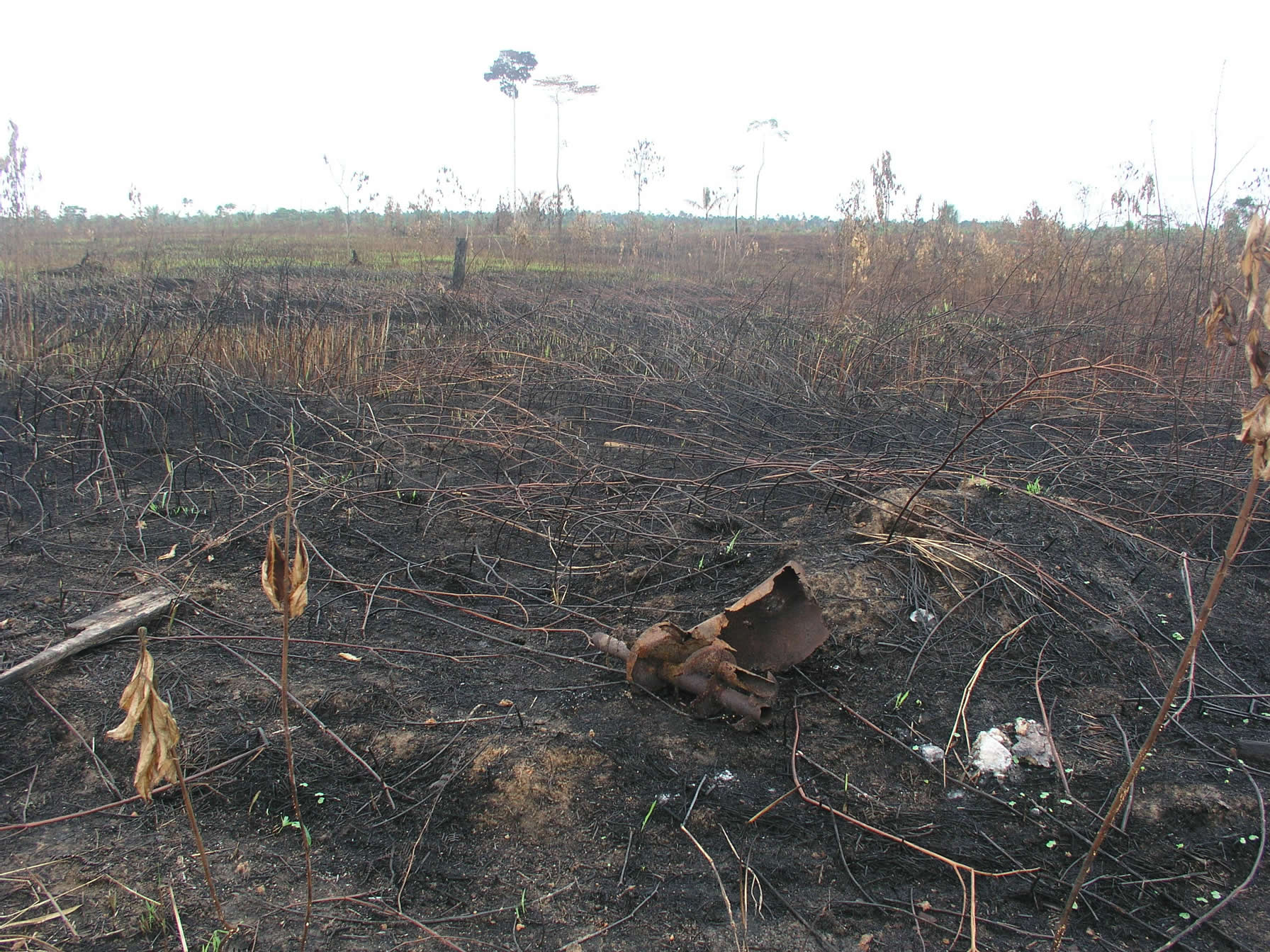 Abandonment of agricultural lands often leads to frequent fires and continuing degradation.
Abandonment of agricultural lands often leads to frequent fires and continuing degradation.Abandoned Lands, Resource Degradation, and the Future of Peruvian Amazonia. The abandonment and subsequent degradation of lands in western Amazonia is leading to a host of environmental, social, and economic problems, including recurrent fires, social conflict, increased crimes against property and persons, and loss of livelihoods. Led by Garden scientist Dr. Christine Padoch, this comprehensive program of multi-disciplinary research on the drivers, processes, and effects of land abandonment and degradation in the Peruvian Amazon is informing broad, science-based policy for diversified and sustainable land use and tenure in Amazonia.
Building Bridges for Sustainable Forestry in the Selva Maya, Mexico: Phase II. The existence of the Selva Maya—the most extensive tract of tropical moist forest in Central America—can be largely credited to members of the local communities who have been managing and conserving the forests of the region for millennia. Led by Garden scientist Dr. Charles Peters, the project is providing technical assistance to local communities (ejidos) so that they can continue to manage their forests and qualify for certification by the Forest Stewardship Council (FSC). A primary focus is the collection of quantitative growth data for over 20 commercial timber species.
 Managed ejido forest in the Selva Maya showing stump of sustainably-harvested mahogany (Swietenia macrophylla) tree.
Managed ejido forest in the Selva Maya showing stump of sustainably-harvested mahogany (Swietenia macrophylla) tree.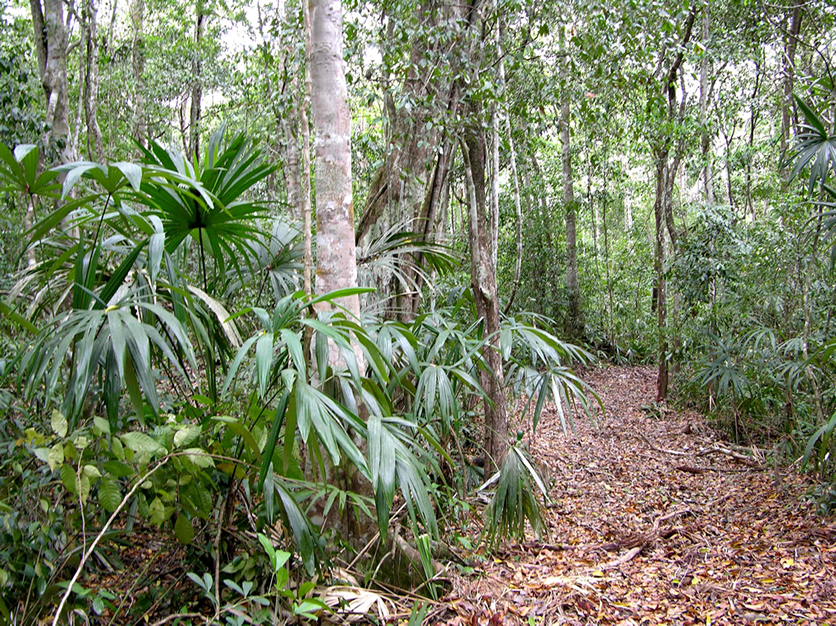 In the Selva Maya of Mexico. Local communities have been managing and conserving areas of this vast tropical moist forest for millennia
In the Selva Maya of Mexico. Local communities have been managing and conserving areas of this vast tropical moist forest for millenniaChanging Biodiversity-Related Standards and Protocols for Forest Management in Amazonia. Led by Garden scientist Dr. Douglas Daly, this project, a partnership with the World Wildlife Fund-Brasil, Instituto Floresta Tropical, Acre state agencies, and the University of Acre, is developing better standards and protocols for inventory, identification, and characterization of forest resources being managed for timber in the Amazon. An important part of the project focuses on developing new tools for reliable field identification of trees.
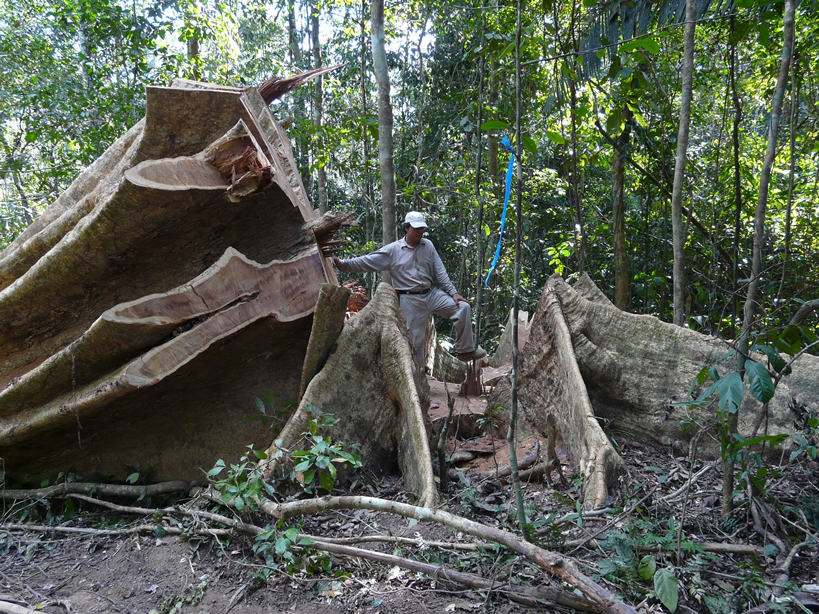 As Brazil and other tropical countries rachet up timber production from native forests, Garden scientists and local collaborators work to provide timber operations and government agencies with training and strategies to identify and protect tree diversity and move toward truly sustainable management.
As Brazil and other tropical countries rachet up timber production from native forests, Garden scientists and local collaborators work to provide timber operations and government agencies with training and strategies to identify and protect tree diversity and move toward truly sustainable management. Forest inventories in the Amazon Basin inform management plans for timber. Unfortunately, current practice for many inventories is to assign the same timber identification to what are actually 4-5 different tree species—and can be up to 30 different species. A number of these “invisible” timber species are rare. Even closely related timber tree species can have very different physical properties and carbon content.
Forest inventories in the Amazon Basin inform management plans for timber. Unfortunately, current practice for many inventories is to assign the same timber identification to what are actually 4-5 different tree species—and can be up to 30 different species. A number of these “invisible” timber species are rare. Even closely related timber tree species can have very different physical properties and carbon content.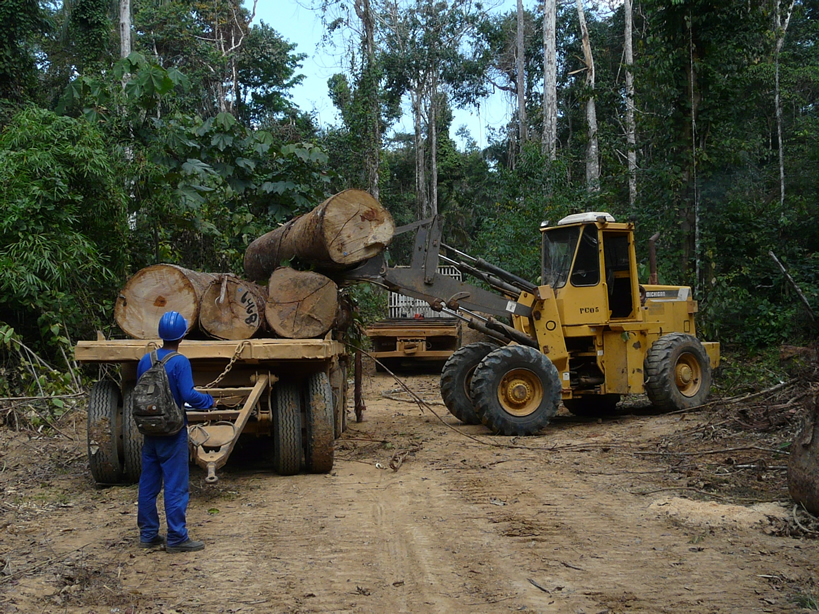 Timber harvesting techniques in the Amazon Basin have vastly improved in recent years, making it possible to reduce collateral damage and avoid harming small watersheds. Unfortunately, the standards and protocols related to conserving tree diversity are still extremely primitive.
Timber harvesting techniques in the Amazon Basin have vastly improved in recent years, making it possible to reduce collateral damage and avoid harming small watersheds. Unfortunately, the standards and protocols related to conserving tree diversity are still extremely primitive.Community-Based Natural Resource Management in the Hukaung Valley Wildlife Sanctuary, Myanmar. Led by Garden scientist Dr. Charles Peters, in collaboration with the Wildlife Conservation Society and the Myanmar Forestry Department, the project is documenting the supply and demand for forest resources—timber, thatch, rattan, medicinal plants, and others—among Kachin communities living along the Ledo Road in the Hukaung Valley Wildlife Sanctuary. Project data have led to the establishment of an intensive management area outside the village of Shinlonga to provide a reliable flow of these resources and train villagers in the mechanics of sustainable forestry. Find out more information.
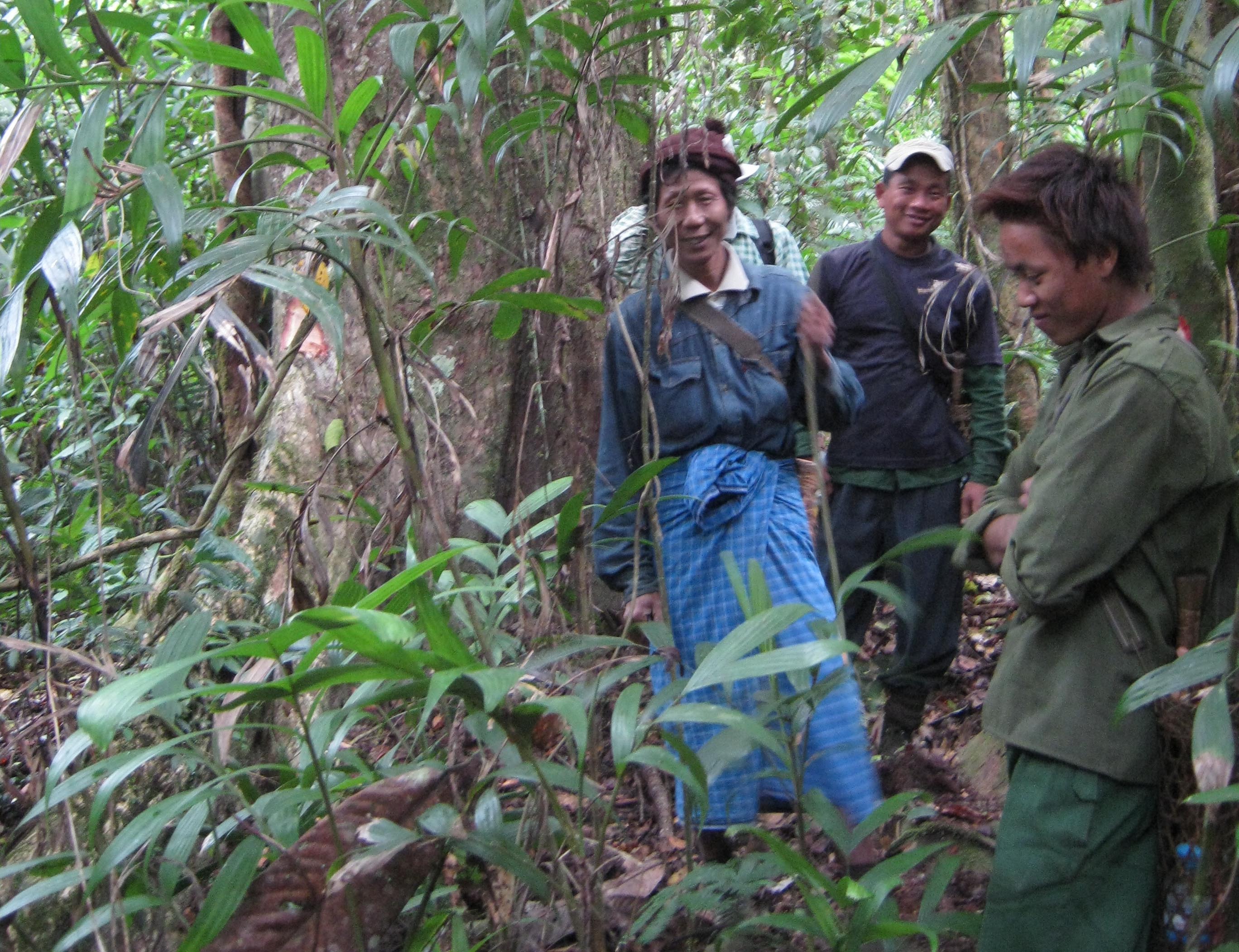 Kachin crews working in the 100 hectare Village Management Area located north of Shinlonga in Myanmar.
Kachin crews working in the 100 hectare Village Management Area located north of Shinlonga in Myanmar.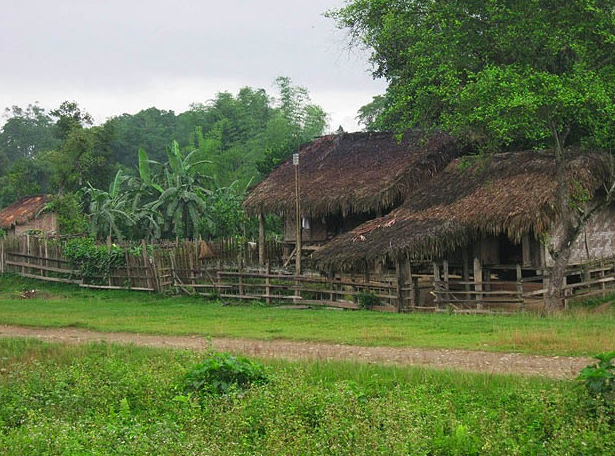 Typical Kachin house located along the Ledo Road in the village of Shinlonga, Myanmar.
Typical Kachin house located along the Ledo Road in the village of Shinlonga, Myanmar.Video. Hukaung Valley Rattan Survey.
Video. Makeshift bridges on the Ledo Road in northern Myanmar are built with boards and long wooden poles lashed together with rattan.Community Management of Wild Maguey (Agave spp.) in Mexico: Phase II. The cultural and economic importance of wild maguey (genus Agave) for making mescal is a strong motivation for conserving tropical dry forests in Mexico. Local communities have developed very sophisticated systems for ensuring that the maguey resource is not over-exploited. Led by Garden scientist Dr. Charles Peters, the project is documenting local management techniques and providing technical assistance and training materials necessary to extend the tradition of community mescal production and promote the conservation and sustainable use of tropical dry forests.
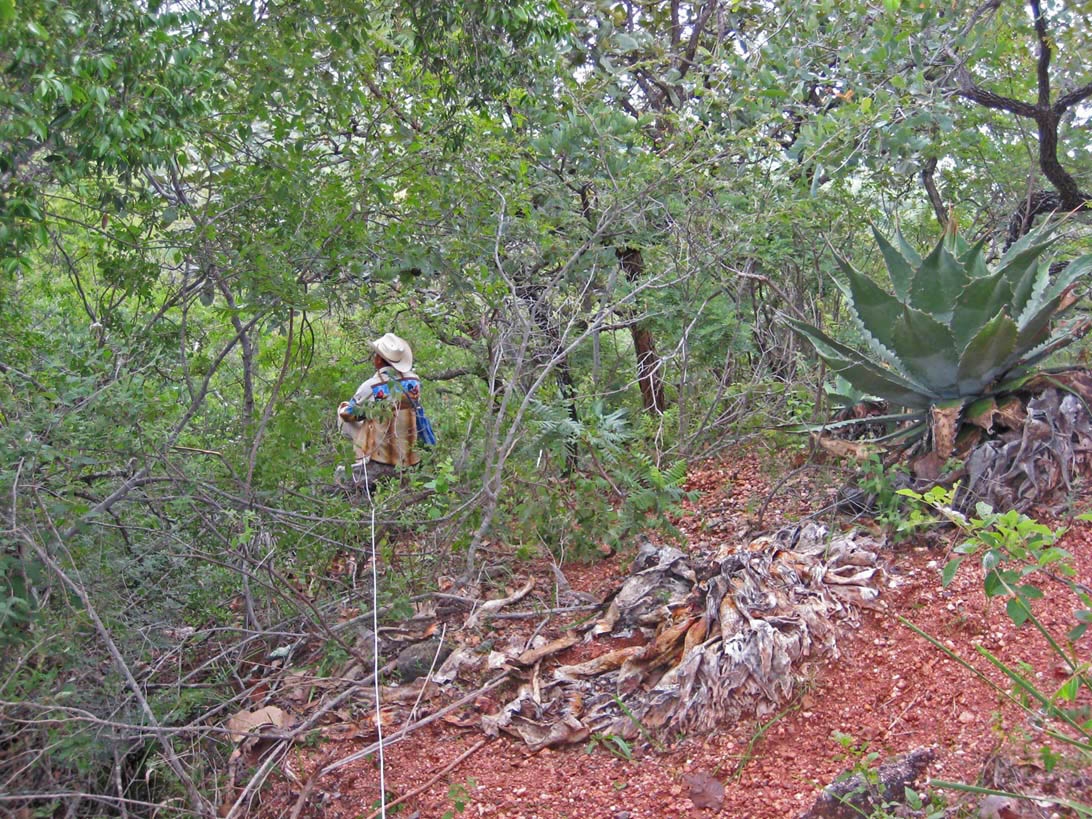 Villagers from Acateyahualco, Guerrero conducting an agave (Agave cupreata) inventory. A large agave plant is shown to the right.
Villagers from Acateyahualco, Guerrero conducting an agave (Agave cupreata) inventory. A large agave plant is shown to the right. Garden scientist Dr. Charles Peters met with villagers in Acateyalualco, Guerreo, Mexico to discuss data on the density and size distribution of local maguey (Agave cupreata) populations they use to make the alcoholic drink “mescal.” Some attendees (left) were initially skeptical about the utility of all this, but by the end of the meeting it was hard to argue with the logic that knowing how many maguey plants you have is much better than blindly harvesting the resource until it disappears.
Garden scientist Dr. Charles Peters met with villagers in Acateyalualco, Guerreo, Mexico to discuss data on the density and size distribution of local maguey (Agave cupreata) populations they use to make the alcoholic drink “mescal.” Some attendees (left) were initially skeptical about the utility of all this, but by the end of the meeting it was hard to argue with the logic that knowing how many maguey plants you have is much better than blindly harvesting the resource until it disappears.
Botanical Explorations of the Pampa del Madidi, Bolivia. Madidi's Pampa are vast grasslands containing a scattered complex of plant communities high in species found nowhere else. Led by Garden scientist Dr. Benjamin Torke in conjunction with the Wildlife Conservation Society, the project is conducting rapid assessments of plant species richness and conservation status in the remote region. Project assessments will aid local initiatives to formally protect the grasslands and develop management plans for them.
Biodiversity and Human Health in the Republic of Palau, Micronesia. Led by Garden scientists Drs. Michael Balick and Wayne Law, in collaboration with a local team from the Belau National Museum and other international researchers, the project is documenting the plants of Palau and their traditional uses. Project data are being used to identify key habitats for conservation and to produce a checklist of Palauan vascular plants, an ethnobotanical manual of Palauan plants and their uses, and a primary healthcare manual based on traditional Palauan plant medicines.
Biodiversity and Human Health in Kosrae, Federated States of Micronesia. The largely unspoiled island of Kosrae is home to steep mountains and the only intact Terminalia carolinensis forest in the world. Led by Garden scientists Drs. Wayne Law and Michael Balick, the project is exploring the island's biodiversity and culture. Data from the project will be used to identify key habitats on Kosrae as part of the Micronesia Challenge, a region-wide conservation program. It will also be used to produce a checklist of the vascular plants of Kosrae, along with an ethnobotanical manual of Kosraean plants and their uses.
Biodiversity and Human Health in Pohnpei, Federated States of Micronesia. As part of the Micronesia Challenge, this project led by Garden scientists Drs. Wayne Law and Michael Balick, is helping to identify highly diverse habitats containing rare and endangered plants that should be protected. As a foundation for this conservation work, the project has produced a checklist of the vascular plants of Pohnpei documenting the endemic, indigenous, introduced, and invasive species on the island. It has also produced a primary healthcare manual based on traditional Pohnpeian plant medicines and a book on the ethnobotany of Pohnpei.
Fires in Western Amazonia: Understanding and Modeling the Role of Climatic, Social, Demographic, and Land Use Change. Large fires that have escaped from burning fields and pastures have become common dry-season events, ravaging forests, farms, and settlements in much of Amazonia. In collaboration with researchers from Columbia University, Garden scientist Dr. Christine Padoch is investigating processes of change in land use, migration, urbanization, and climate and their links to the probability of changes in the incidence, size, and severity of escaped fires. Project results will aid understanding of how biological, social, and atmospheric processes are coupled to change the danger of fire damage in complex and rapidly evolving tropical landscapes.
French Guiana e-Flora. Led by Garden scientist Dr. Scott Mori, in collaboration with the French development agency IRD, the project is producing a database-driven, specimen-based, illustrated checklist of the flowering plants of French Guiana and the Nouragues Nature Reserve. At just under 256,000 acres, Nouragues is France's largest nature reserve and a key location for studying tropical forests and their biodiversity.
Find out more information:
French Guianan e-Flora Project
Plant Diversity of Central French Guiana (C.V. Starr Virtual Herbarium)